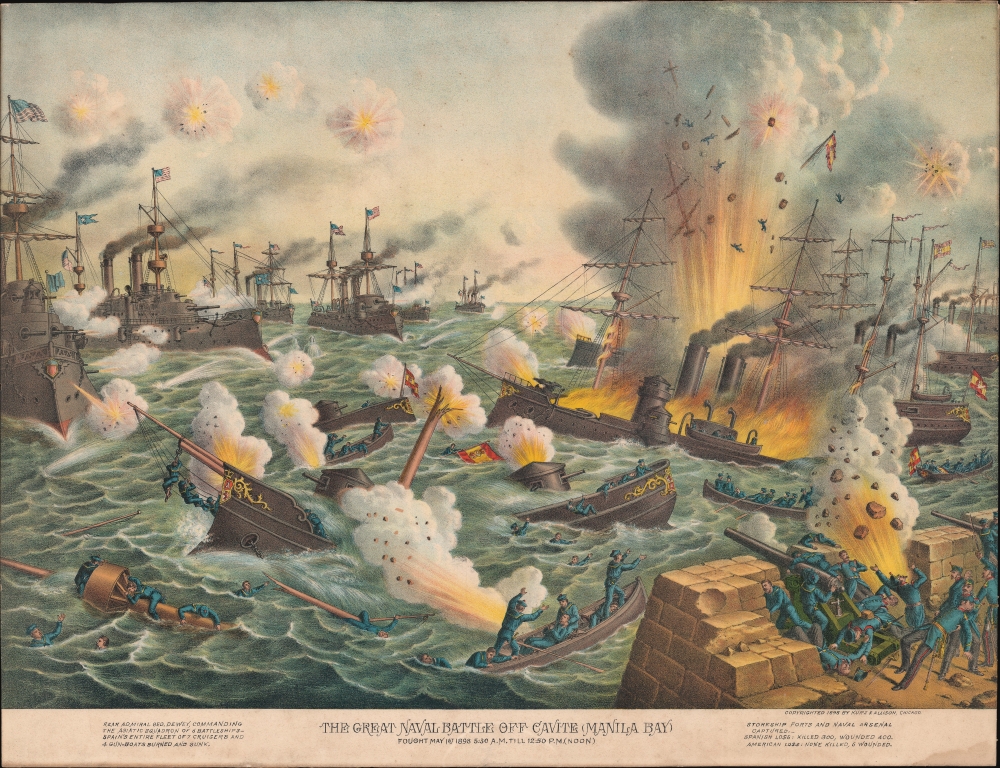1898 Kurz Allison View of the Battle of Manila, Philippines
ManilaBayBattle-kurzallison-1898
Title
1898 (dated) 19 x 24.75 in (48.26 x 62.865 cm)
Description
The Battle of Manila
The American Asiatic Squadron under Commodore George Dewey engaged and destroyed the Spanish Pacific Squadron under Admiral Patricio Montojo. At 5:41 AM, with the now famous command, 'You may fire when ready, Mr. Gridley,' Commodore Dewey instructed Olympia's Captain to begin the bombardment of the Spanish fleet. After a furious exchange of fire, Captain Gridley messaged Dewey that only 15 rounds of ammunition remained per gun. Concerned, Dewey ordered an immediate withdraw. So as not to alarm the crew, he announced that they were 'pausing for breakfast' - which they proceeded to enjoy. During this historic 'breakfast' it became apparent that the communication had gone awry and that the actual message was that Gridley has 'expended only 15 rounds of ammunition per gun.' The Battle commenced at 10:40 AM and followed with the surrender and total destruction of the Spanish squadron. The Spanish colors were struck at 12:40 PM.The Spanish-American War
The Spanish-American War was fought between Spain and the United States between April 21, 1898, and August 13, 1898. The war started after the USS Maine suffered a massive explosion and sank in Havana Harbor. Tensions had been rising between the two countries for some time, with the U.S. showing support for Cuban independence while Spain claimed Cuba to be a province of Spain. After the fighting ended, the U.S. received the Philippines, Guam, and Puerto Rico along with Cuba as a U.S. protectorate.Chromolithography
Chromolithography, sometimes called oleography, is a color lithographic technique developed in the mid-19th century. The process involved using multiple lithographic stones, one for each color, to yield a rich composite effect. Oftentimes, the process would start with a black basecoat upon which subsequent colors were layered. Some chromolithographs used 30 or more separate lithographic stones to achieve the desired product. Chromolithograph color could also be effectively blended for even more dramatic results. The process became extremely popular in the late 19th and early 20th centuries when it emerged as the dominant method of color printing. The vivid color chromolithography produced made it exceptionally effective for advertising and propaganda imagery.Publication History and Census
This view was published by Kurz and Allison in 1898, shortly after the events depicted. It is one of two views issued by that firm, both of which are similar, but clearly different plates. The present view is the larger and rarer of the two. The smaller view, of which we see a copy in the Library of Congress, can be identified by typesetting and slight variations in the content, and its smaller size. It is not clear why two very similar editions were published near simultaneously, given the extreme labor in producing multiple plates for chromolithography. Perhaps the first plate was somehow damaged or destroyed? This view was likely meant to partner with a similar view of the destruction of the Battleship Maine (Geographicus: DestructionMaine-kurzallison-1898). Examples of the present edition are scarce and usually fragmentary. We note one example at the Mariner's Museum and Park, and at the Wolfsonian-FIU.Cartographer
Kurz and Allison (1880 - c. 1905) was an American publishing firm known for its chromolithographs. Founded by Louis Kurz (1835 - 1921) and Alexander Allison, the firm was based at 267-269 Wabash Avenue in Chicago. In the partnership, it is known that Kurz, an Austrian immigrant, was the lithographer and it is presumed that Allison provided the financial backing. The firm is most well-known for its series of thirty-six battle scenes from the American Civil War. At the time of their publication, the late 1880s and early 1890s, a general nostalgia was prevalent among Civil War veterans (of which Kurz was one), and evidently the company was trying to capitalize on the sentiment. Kurz and Allison's Civil War prints were not the first such prints to be issued, but they were by far the most popular. In a style reminiscent of Currier and Ives, Kurz and Allison lithographs are not meant to be historical representations, and even, from time to time, included historical inaccuracies. Even so, 'prints depicting the Civil War battles by Kurz and Allison are among the most sought-after collectibles of Civil War enthusiasts.' Their prints are also notable for featuring African-American soldiers, a rarity for the era. After the outbreak of the Spanish-American War, the firm published views from famous battles and continued doing so for the campaigns of the Philippine-American War and the Russo-Japanese War. More by this mapmaker...

